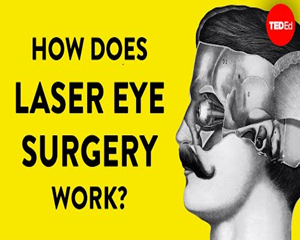In 1948, Spanish ophthalmologist Jose Ignacio Barraquer Moner was fed up with glasses.
1948年,西班牙眼科医生何塞·伊格纳西奥·巴拉奎尔·莫纳受够了戴眼镜。
He wanted a solution for blurry vision that fixed the eye itself, without relying on external aids.
他想要找到修复眼睛本身的方法来解决视力模糊的问题,而无需依靠外部帮助。
But the surgery he eventually devised was not for the faint of heart.
但他最终设计的手术方案并不适合胆小的人。
Barraquer began by slicing off the front of a patient's cornea and dunking it in liquid nitrogen.
巴拉奎尔通过切下患者前侧眼角膜,并将其泡在氮液中。
Using a miniature lathe, he ground the frozen cornea into the precise shape necessary to focus the patient's vision.
通过使用微型车床,他将冰冻的眼角膜磨成能够让病人视力聚焦的精准形状。
Then he thawed the disc, and sewed it back on.
接着,他把这个圆盘解冻后再缝合回去。
Barraquer called this procedure keratomileusis, from the Greek words for "carving" and "cornea."
巴拉奎尔把这种手术称为角膜磨镶术,源自希腊语中的“雕刻”和“角膜”。
And though it might sound grisly, his technique produced reliable results. So how did Barraquer's surgery work?
这虽然听起来很可怕,但他的技术却十分可靠。那么,巴拉奎尔的手术是如何操作的呢?
Keratomileusis corrects what are called refractive errors: imperfections in the way the eye focuses incoming light.
角膜磨镶术矫正了所谓的屈光不正,即眼睛无法将射入的光线完美地进行对焦。
Ideally, the cornea and lens work together to focus light on the surface of the retina,
理想情况下,角膜和晶状体共同作用将光线聚焦再视网膜表面上,
but several kinds of refractive errors can impair this delicate system.
但是几种屈光不正会破坏这个精巧的系统。
In people with myopia, or short-sightedness, a steep cornea focuses light just short of the retina.
在近视的人群中,较陡的角膜使得聚焦的光线刚好无法抵达到视网膜。
Those with hyperopia, or far-sightedness, have the opposite problem: light is focused too far beyond the retina.
远视的人则有刚好相反的问题:光线聚焦在远超过视网膜的地方。
And in people with astigmatism, the cornea has two different curvatures which focus light at two distances and produce blurry vision.
而患有散光的人,角膜有两个不同的曲率使光线有两个不同的聚焦点,造成视力模糊。
Even those with perfect vision will eventually suffer from presbyopia, or "aging eyes."
即使视力完美的人,最终眼睛也会老化,即“老花眼”。
As the proteins in the lens age, they slowly increase its size.
随着晶状体中的蛋白质老化,它们会慢慢变大。
By an adult's mid-40's, the lens is too large to easily change shape and shift focus.
成年人到了四十岁左右,晶状体由于太大而不易改变形状和转移焦点。
Glasses and contact lenses bend light to compensate for these refractive errors.
眼镜和隐形眼镜会改变光线方向以补偿这种屈光不正。
But, as Barraquer's procedure shows, we can also alter the shape of the cornea itself;
但是,如同巴拉奎尔的手术所表明的,我们也可以改变角膜本身的形状,
moving the focal point backwards, forwards, or pulling a divided image together.
将焦点向前或向后移动,或让分离的图像重叠回到一起。
And thankfully, modern eye surgeons can sculpt the cornea with far less invasive tools.
幸好,现代眼科手术可以使用创口更小的工具雕刻角膜。
In corrective laser eye surgery, surgeons rely on excimer lasers.
在激光矫正眼科手术中,外科医生依靠准分子激光器。
These tools are accurate enough to etch words into a human hair.
这些工具精准到可以在人类的头发上刻字。

To safely accomplish these ultra-fine incisions, they use a technique called photoablation.
为了安全地完成这些超精细切割,他们使用一种叫做光消融的技术。
This allows the laser to essentially evaporate organic tissue without overheating surrounding eye tissue.
基本上,这种技术使用激光让有机组织蒸发,而不会让周围眼组织过热。
So how does laser eye surgery actually work?
那么,激光眼科手术到底是怎么运行的呢?
The first step is to separate a thin layer from the front of the cornea.
第一步是将角膜前侧分离出薄薄的一层。
This can be done with either a flat, wide blade, or a femto-second laser
这既可以使用平宽的刀片,也可以使用飞秒激光,
that produces millions of tiny plasma bubbles to create a plane beneath the corneal surface.
它可以产生数百万个微小的等离子气泡,在角膜表面下形成一个平面。
Surgeons then lift the flap to expose the inside of the cornea.
接着,外科医生会将角膜瓣掀开,露出角膜内部。
Guided by the refractive error and the shape of the cornea,
根据屈光偏差和角膜形状,
the excimer laser robotically sculpts the exposed corneal bed into the correct shape.
准分子激光会自动将暴露的角膜床雕刻成正确的形状。
This process usually takes less than 30 seconds for each eye.
这一过程对于每只眼睛通常只需要不到30秒。
Finally, the flap is closed, and its edges reseal themselves in just a few hours.
最后,将角膜瓣放回原位,只需几小时,它的边缘会自然地愈合。
Because the lasering is done on the eyeball itself, it's described as "in situ," or "on site."
因为激光手术是在眼球上进行,这在手术中被称为“原位”的。
Its complete name is "laser in-situ keratomileusis" -- but you probably know it as LASIK.
全称为“准分子激光原位角膜磨镶术”,但大家熟知的可能是“LASIK”。
Essentially, this technique carves a patient's contact lens prescription onto their cornea.
基本上,这项技术是将患者的隐形眼镜处方直接刻到其角膜上。
Like any surgical procedure, LASIK comes with certain risks.
和其他任何外科手术一样,LASIK手术也伴随着风险。
Some patients experience slightly blurred vision that can't be corrected by glasses.
有些患者会出现轻微的视线模糊,且无法通过佩戴眼镜矫正。
But the technique is currently about as likely to damage your eyes as wearing daily disposable contact lenses for one year.
但这项技术目前对于眼睛的伤害如同佩戴一年的日抛型隐形眼。
Today, a technique called SMILE enables surgeons to sculpt the cornea through even smaller incisions -- further reducing recovery time.
如今,外科医生通过一项名为SMILE的技术来雕刻角膜,通过更小的切口,进一步缩短了恢复的时间。
And lasers aren't just correcting the three types of refractive errors -- this technology can also restore aging eyes.
激光手术不仅可以矫正三类屈光不正,这项技术还可以修复老花眼。
In a technique called Laser Blended Vision,
有一种叫做激光混合视觉的技术,
surgeons adjust one eye to be slightly better at distance vision and the other to be better at close range vision.
外科医生微调一只眼睛,使其远距视线更好,然后微调另一只眼睛,使其近距离视线更好。
The difference between the two eyes is small enough that most patients can merge their vision,
两个眼睛之间的区别足够小到使大部分患者可以合并视线,
allowing both eyes to work together at all distances.
让两只眼睛可以一起看不同的距离。
Advances in laser technology continue to make vision correction surgery more effective and accessible.
激光手术的持续进步,使得视力矫正手术更加高效和便利。
One day soon, Barraquer's vision of a world without glasses may finally come true.
巴拉奎尔的愿景:一个没有眼镜的的世界,在不久的将来,或许将会实现。












